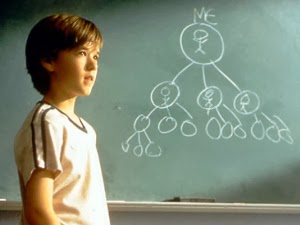(Este é um resumo do texto
de Andrew Hardie)
Briefing:
Language Acquisition
(L.Ac.) by Andrew Hardie -
37.1: The author takes
a general overview of the process of L.Ac. And then goes on to
consider two examples of theories for L.Ac.. his discuss covers many
points to the acquisition of any language but particular details are
all realated to Englihs in this chapter.
37.2: transition
when a child learns English from natural (biological) to phonetic
sounds.
From non-meaningful
vocalization to words and the transition from single words to
grammatical structure.
37.2.1: From sounds
to speech sounds
Non-linguistic
sounds as crying (earliest sounds) in children is stimulated by
physical or psychilogical discomfort or distress (when it is hungry,
in pain, angry, or when it desires attention from a caregiver; other
are by burping, swallowing and sneezing without control over the
production of these sounds. When it is 2 months or more, cooing and
laughter are added. Then it is nocticing the earliest stage oa
acquring consonants, children would produce a very wide range of
consonant sounds - Any language of the world.
“a
baby in an English-speaking environment might produce click
consonants or pharyngeal consonants, at the outset (...even though
these sounds are not found in English.” (p.610)
Today
is hard to confirm Jakobson's theory “Cause very young babies are
shaped more like those of non-human apes than those of adult humans.”
Phonems
as: Velar or glottal - h / w / k / but kids do not make, are not
able to distinctions;
Plosives
: Produced the front of oral plosives: p / b/ t/ and / d /;
p
|
pen, copy, happen
|
b
|
back, baby, job
|
t
|
tea, tight, button
|
d
|
day, ladder, odd
|
nasal: n and m;
m
|
more, hammer, sum
|
n
|
nice, know, funny, sun
|
ŋ
|
ring, anger, thanks, sung
|
Fricatives:
/ s /versus / ʃ / or / f
/ versus / θ /
f
|
fat, coffee, rough, photo
|
v
|
view, heavy, move
|
θ
|
thing, author, path
|
ð
|
this, other, smooth
|
s
|
soon, cease, sister
|
z
|
zero, music, roses, buzz
|
ʃ
|
ship, sure, national
|
ʒ
|
pleasure, vision
|
Affricatives:
tʃ
|
church, match, nature
|
dʒ
|
judge, age, soldier
|
liquids:
l
|
light, valley, feel
|
r
|
right, wrong, sorry, arrange
|
Vowels are tipically mastered much earlier (about 3 years old);
Vowels are less discrete;
consonants are clearly distinguishable in terms of place of
articulation and manner of articulation;
Vowels exist on a continuum.
37.2.2: - From
pre-words to words – (p.611)
Babbling:
speech are first connected
together into larger phonetic units, it takes the form of babbling
(a.k.a. Vocal play) occurs in children from around 3rd
4th
month of life. Even deaf children have been found to “Babble” -
is an innate part od development in L.Ac.
It
is teh production of repeating strings of alternating consonants and
vowels, such as [ bababa] or [gagaga]. Children seem to enjoy this
form of vocal play.
In
babble articulates “glottal, velar and labial consonants”, with
later [b], [d],[m] and [n] becoming + important. Babbling
(non-meaningful) =/ speech (meaningful)
Vocal
gestures: At
this stages the child becomes capable of using precursos to words –
phonetic units which are more stable in form than babbling, and which
seem to have some kind of meaning. They are vague and more a gesture
than a word. But some researchers have used a range of terminology to
describe them.
DORE
and colleagues (1976) described these as “phonetically consistent
forms”.
HALLIDAY
(1975) described these as “ proto-words”.
their meaning are
restricted to the context in which it is used;
when vocalization takes on
a meaning that is independent of its context we can actually begin
to class them as linguistic symbols – early words (HARDIE. p.611)
First
words:
It's been claimed that nouns specially are very prominent in the
early vocabulary, with verbs being somewhat less frequent. The nouns
in question are almost always concrete rather than abstract nouns.
37.2.3:
From words to sentences
- 9th
moths to a year, starting produce these words one at time, putting
words together to produce longer utterance evidencing that they're
basic (but increasingly complex) morphology and syntax.
The
notion of holophrases
(whole sentence) – relates the degree to which the child possesses
the concept of the sentence.
a)
holophrase utterances is that, they are partial representations of
adult sentences – sentences with all but one of the words missed
ou;
b)
teh structure of a sentence is understood by the child, but left
unspoken, due to the child's limited abilities.
Ex:
child speaking: - clock!
Meaning: - there's a clock! Or, - Where's a clock?
Two-word
utterances
(of gramatical development): around 18 months old this two-word satge
has been of great interest to many researchers because it is only
with multi-word utterance that there is scope to investigate teh
early emergence of syntax.
BROWN
and FRASER (1964) suggests that these are basically “telegraphic”.
-Adult
utterances with grammatical words like of and
or the
missed out – explains: sweater chair; mommy sock; baby table, but
not the many two-word utterances that do contain grammatical words,
such as:
BRAINE
(1963) and McNeil (1966) hypothesizes that children have two classes
of words: Pivot words ( 1 ) and Open words ( 2 ):
Pivot
words are restricted to one position in the utterance - 1st
or 2nd
– and ca not occur alone;
Can occur in either
position, or alone. Ex: More milk (milk pivots around); more juice
(juice pivots around); more read (read pivots around).
To
be continued...
read more in:
http://www.ling.lancs.ac.uk/profiles/andrew-hardie
CULPEPER, J. "English Language: description, variation and context (2009). PALMGRAVE MACMILLAN





